Kerameikos Athens is located northwest of Acropolis Hill and Ancient Agora. The site was initially widely known as Kerameikos Pottery as it used to be the potters’ quarter of Ancient Athens.
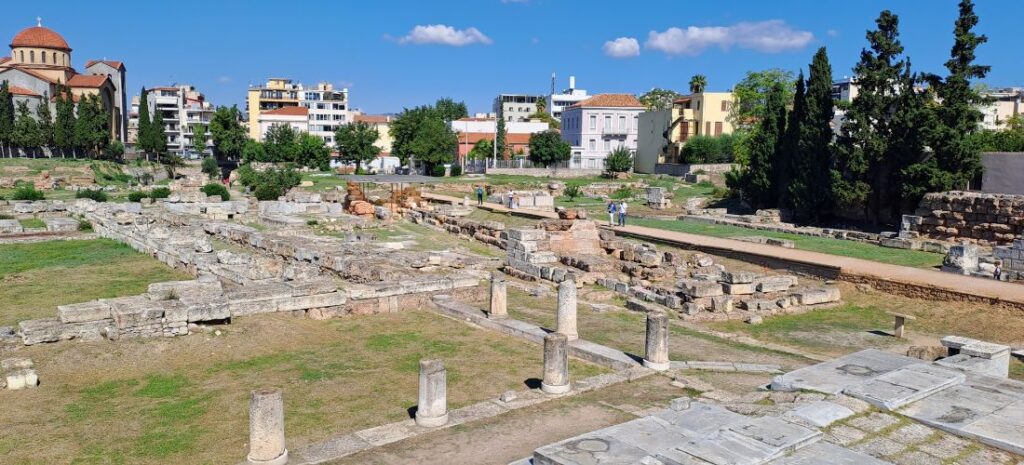
Later the area was also known as Kerameikos Cemetery as this became Athens’ main ancient cemetery with numerous funerary sculptures to have been erected along the Sacred Way. The Sacred Way (or Eleusinean) started from Kerameikos, passing the Daphni Monastery and the Temple of Aphrodite to Eleusis town (21 km from Athens).
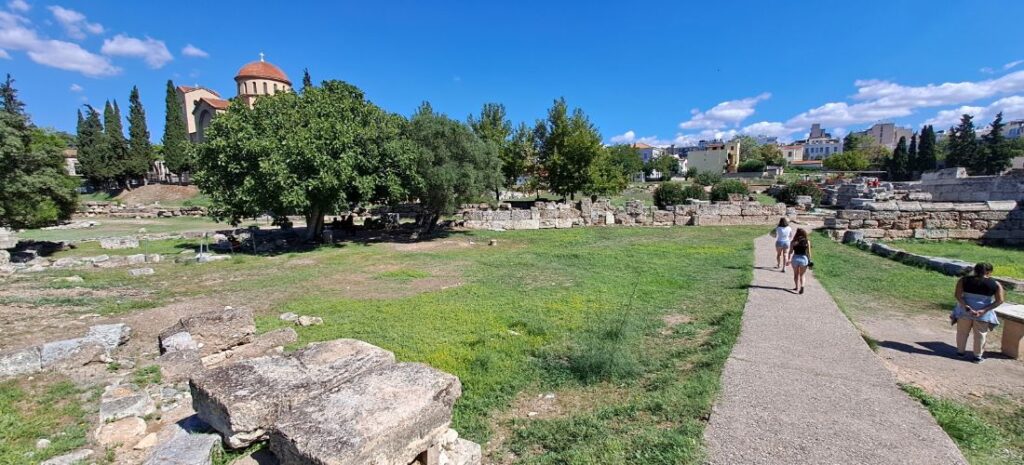
When you visit the Kerameikos archaeological site today you will see a large area with remains of various ancient constructions in its northern part: the Themistoclean walls, Dipylon, Pompeion, and the Greek Orthodox Church of Agia Triada (Holy Trinity).
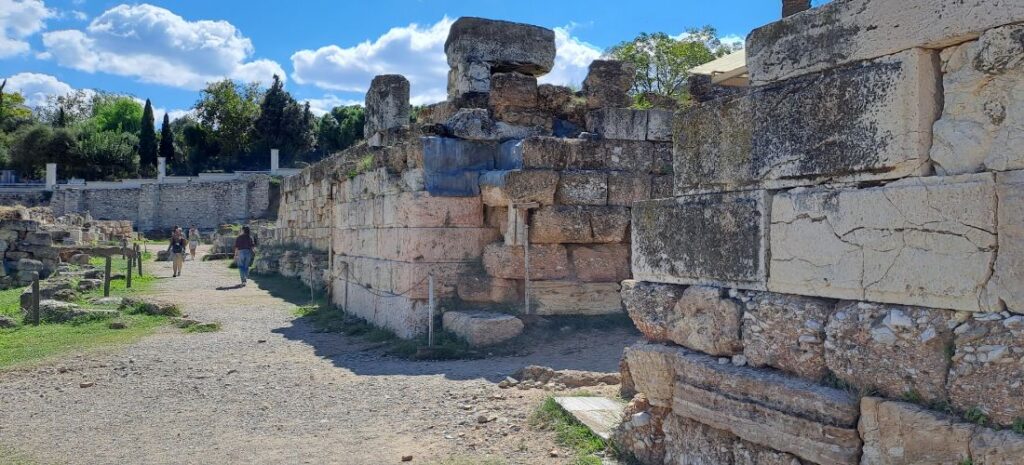
In the western part of the site, among beautiful olive trees, you will walk along impressive tombstones with dedicated inscriptions. This is where the small in-house museum is also located with artifacts from the surrounding Kerameikos Necropolis.
Find in this post how to get to Kerameikos, about the entrance tickets and the opening hours, historical information on the monuments, and the nearby must-visit sites.
Word Tip: the Engish word ‘ceramics’ comes from Kerameikos.
*Some of the links in this post are affiliate links. That means I may make a commission if you click and buy. The commission comes at no additional cost to you.
My Latest Video on Kerameikos
How to Get to Kerameikos Athens
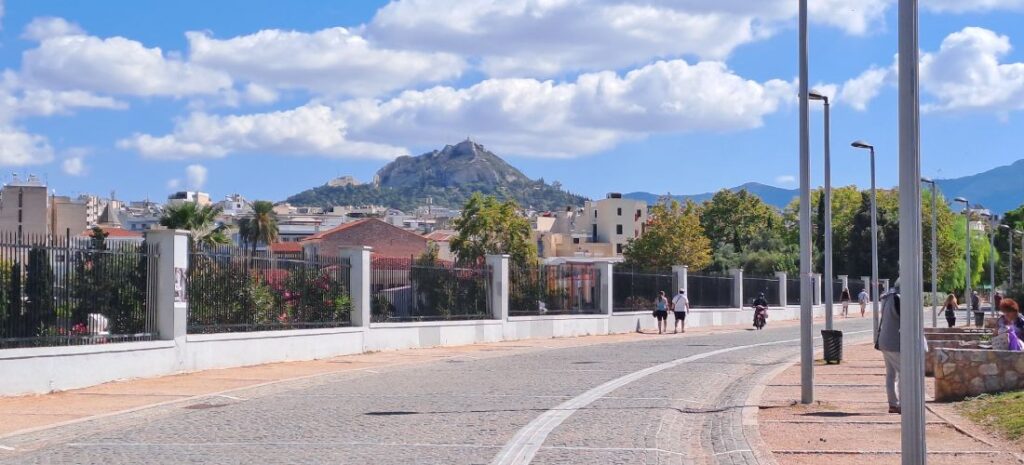
The entrance of the archaeological site of Kerameikos is located 200 meters from Thision metro station, on the pedestrian part of Ermou 148 St. towards Technopolis. Kerameikos is usually combined with a visit to the nearby Ancient Agora of Athens, halfway between Monastiraki and Thisio metro stations. Ancient Agora is the second most important site in Athens.
Tip: You can also get off at Kerameikos metro station and walk to the Kerameikos site, which is a 10-minute walk away. That way you can also explore a very popular Athenian area with cafes and taverns known as Gazi.
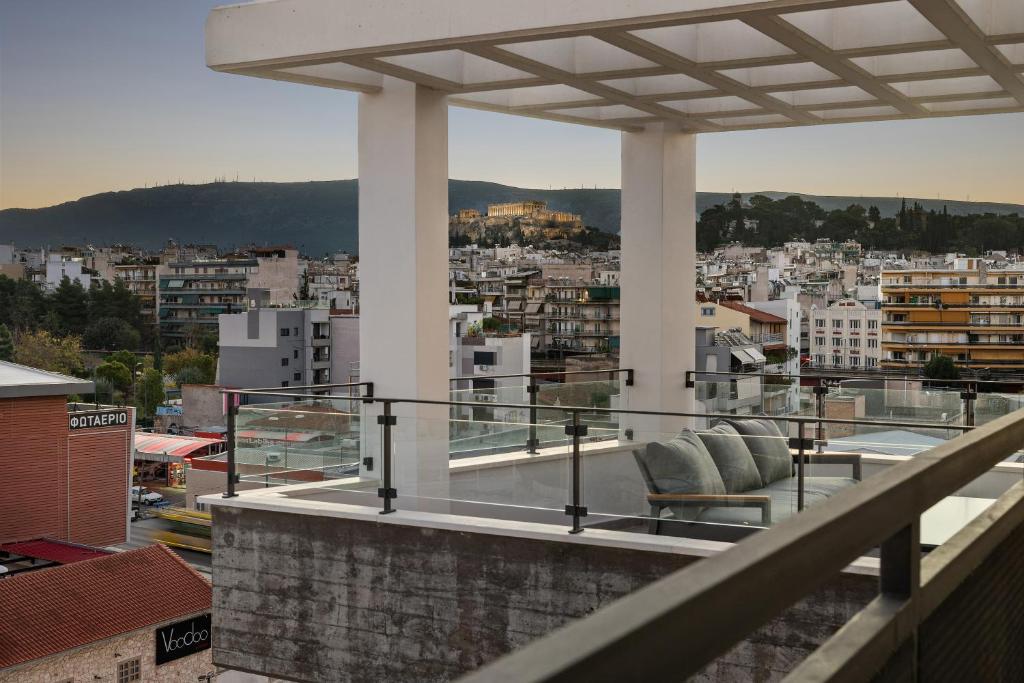
A fantastic apartment in Gazi with Acropolis views is the Athenian View Loft, 5 minutes away from Kerameikos metro and the archaeological site.
What you will see at the Kerameikos Athens
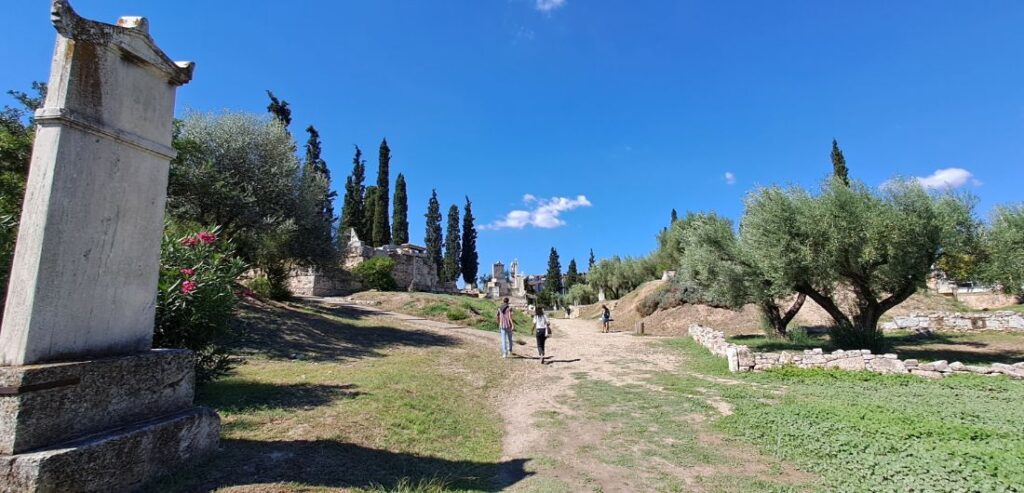
When you get toward the main entrance of the Kerameikos archaeological site you will notice that it is spread a few meters below the ground surface. As you walk around the site, you will walk on the same level as the Athenians did in the Classical period (5th and 4th century BCE).
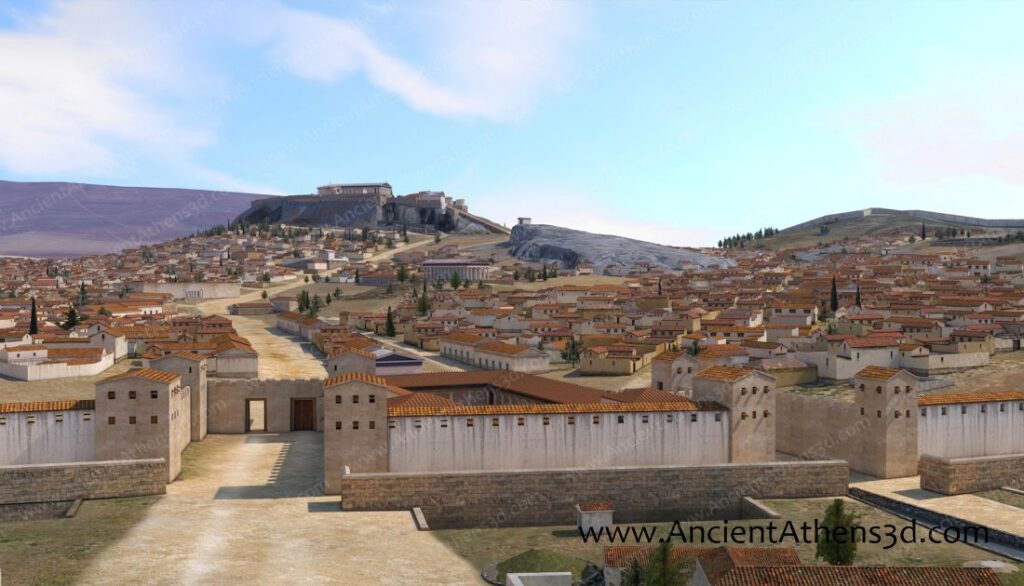
Until 1863 Kerameikos Athens was known only from the texts of Thucydides and Pausanias since the entire area of the ancient cemetery was covered by rubble up to 9 meters high. On top of this rubble were a few small houses and a soap factory. Around this time, the tip of a tombstone was found accidentally and the excavations started.
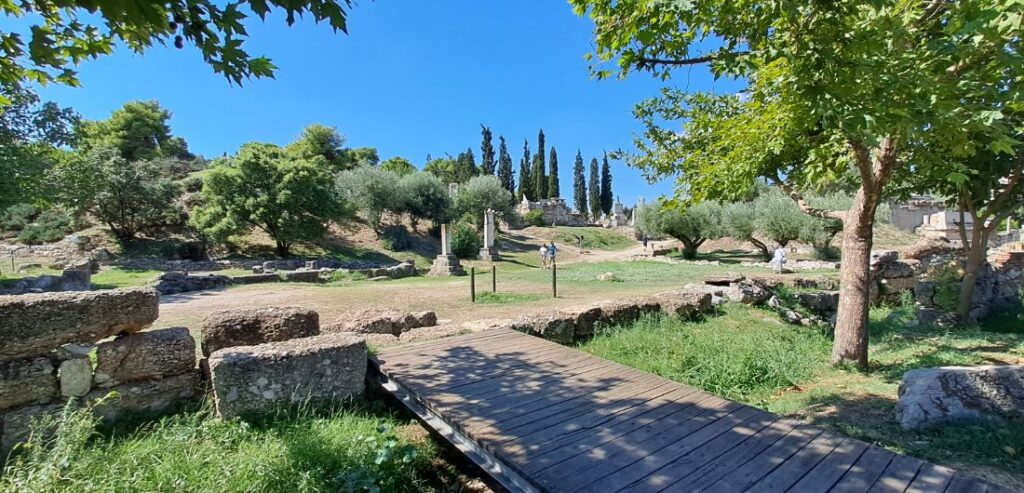
Today the area of Kerameikos is a beautiful outdoor green site with Lycabettus and the Acropolis dominating the horizon. The stream of Iridanos, the vegetation, the turtles, and the occasional basking cat make it a lively area and not the place of the dead.
Kerameikos Pottery and Cemetery
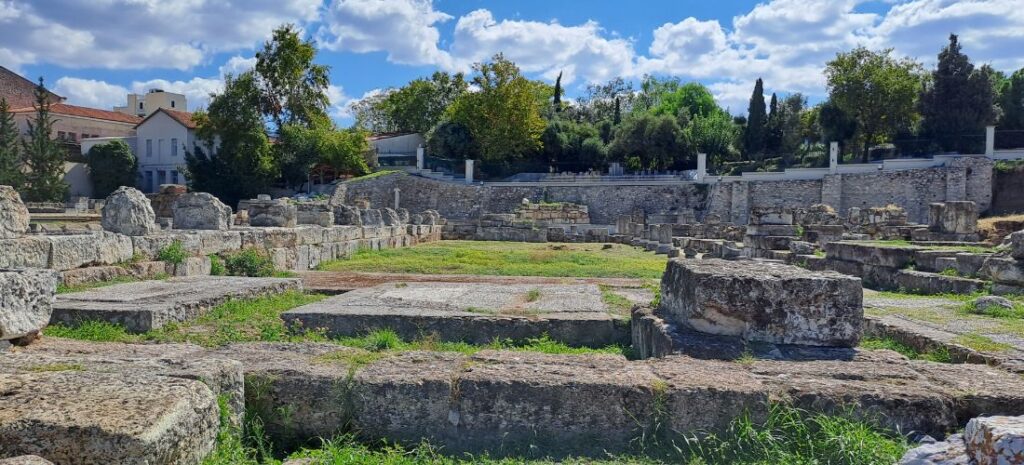
Although Kerameikos has been used as a cemetery as long ago as the 3rd millennium BC it was initially a settlement of potters and vase painters. The whole area was the main production center of the famous Attic ceramic vases.
Potters were drawn to the Kerameikos by the clay deposits of the Iridanos River which had much more water in ancient Athens than it has today. However, the riverbank was often overflowing and destroying the potters’ settlements, who finally abandoned the area.
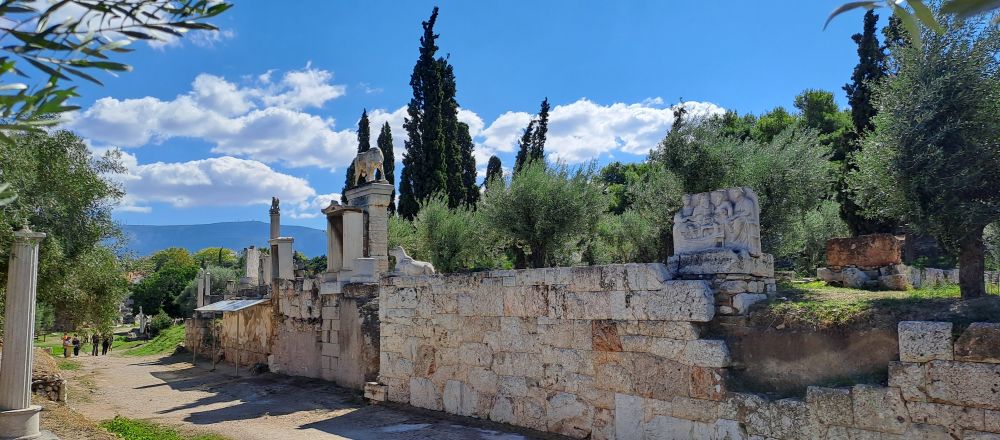
Kerameikos then became one of the most important cemeteries of ancient Athens, from prehistoric to Byzantine times (1,100 BCE – 500 CE). The Athenians buried their prominent citizens, the generals, and warriors who had fallen in battle, even the priestesses in their temples.
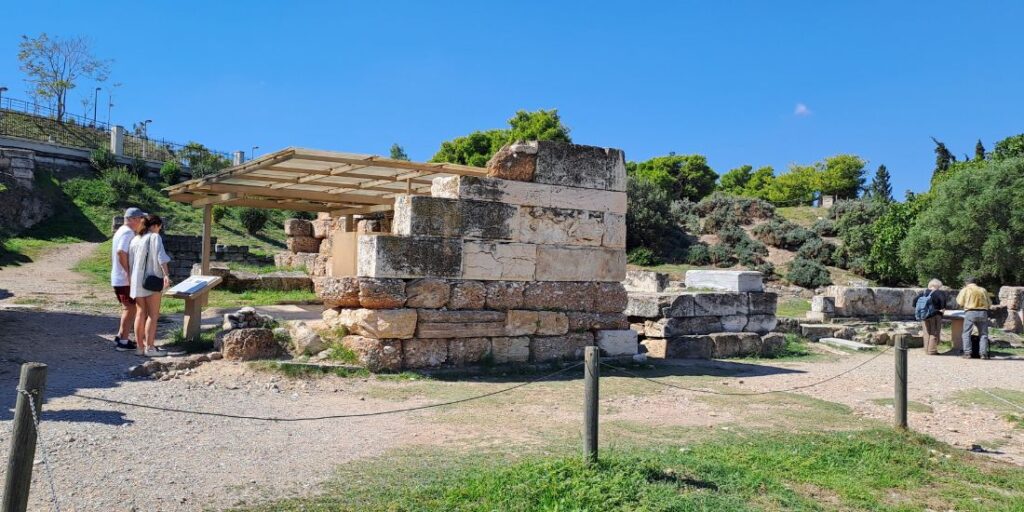
The Athenians have always respected their dead especially those who fell in battle defending the freedom of their homeland. Apart from the various honorable events that they organized, they also constructed magnificent tombstones and funerary monuments of high artistic and cultural quality.
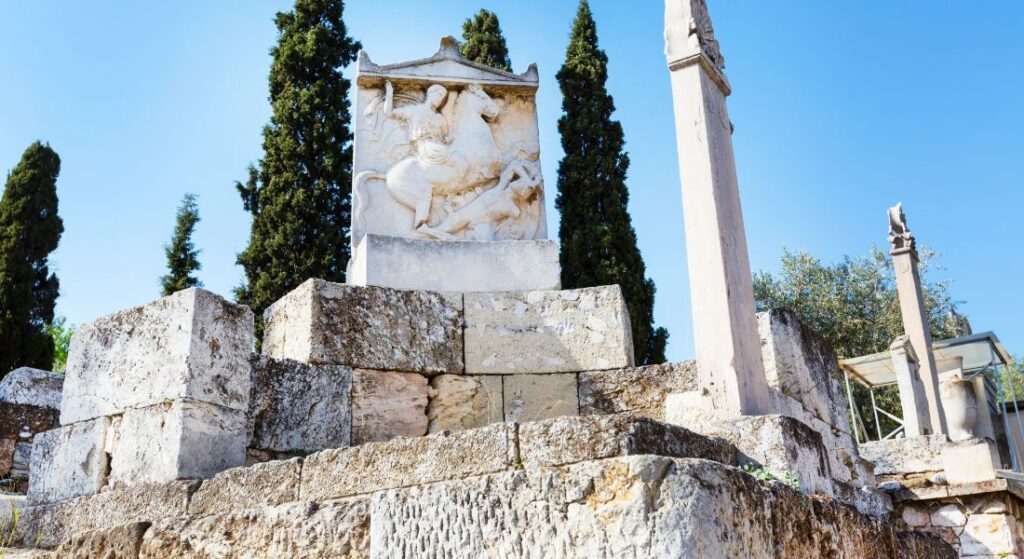
The tombstones were decorated with beautiful relief sculptures that you get to see in the Road of the Dead inside the Kerameikos. Outside the fenced area, in 1994 during the excavations for the Kerameikos metro station, they discovered a group burial of Athenians who had died in the terrible plague that struck the city from 430 to 426 BCE.
Fortification of Kerameikos Athens
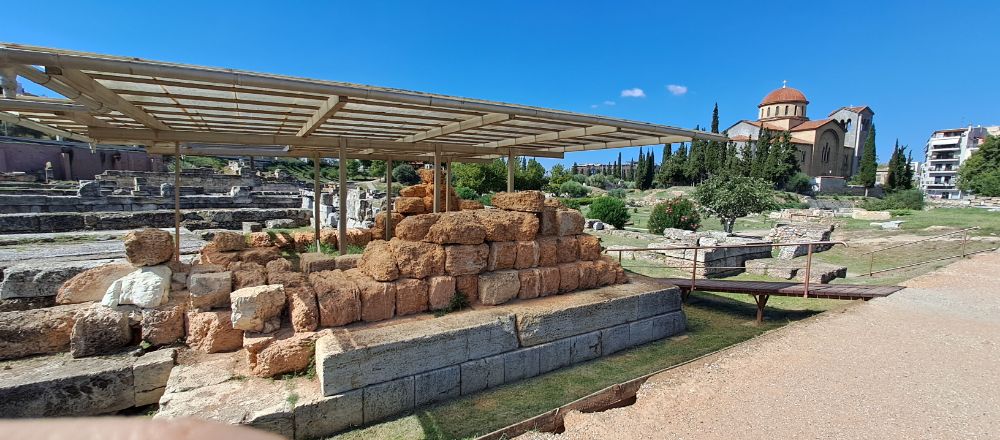
Right after the battles against the invading Persians in Marathon in 490 BCE, in Thermopylae, Artemisio, and Salamina island in 480 BCE, Athenian ruler Themistocles hastily decided to build a wall to protect the city in 478 BC. The walls have remained in history known as Themistoclean.
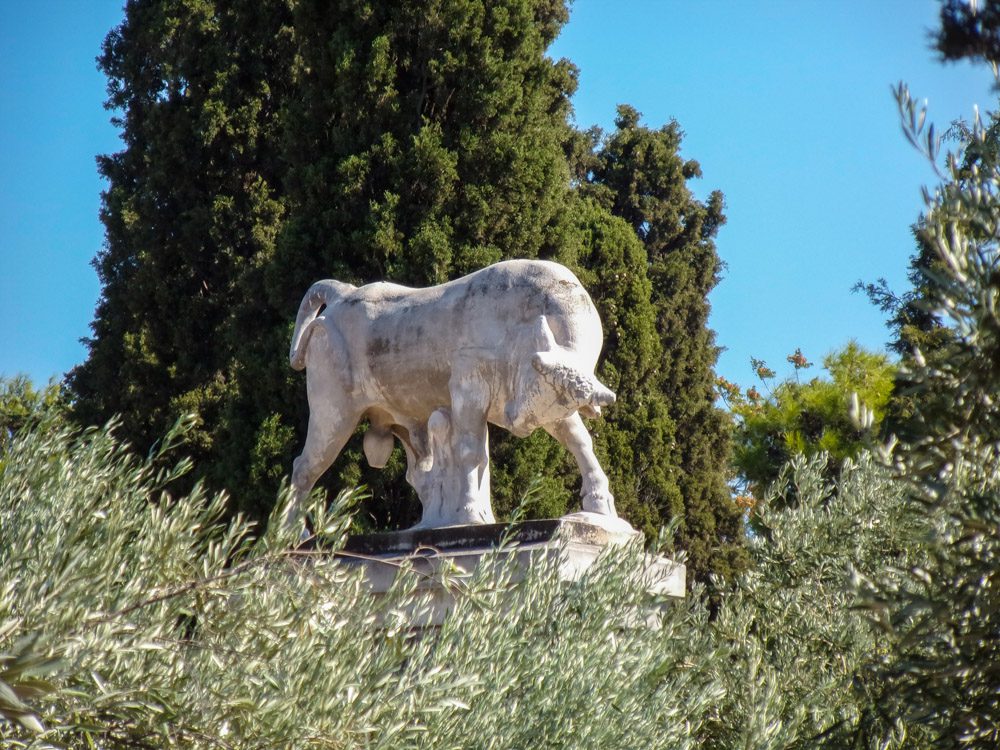
The walls separated Kerameikos into two parts: The Inner Kerameikos – within the walls – used exclusively for residential settlement, and the Exo (outside) Kerameikos, for burial use.
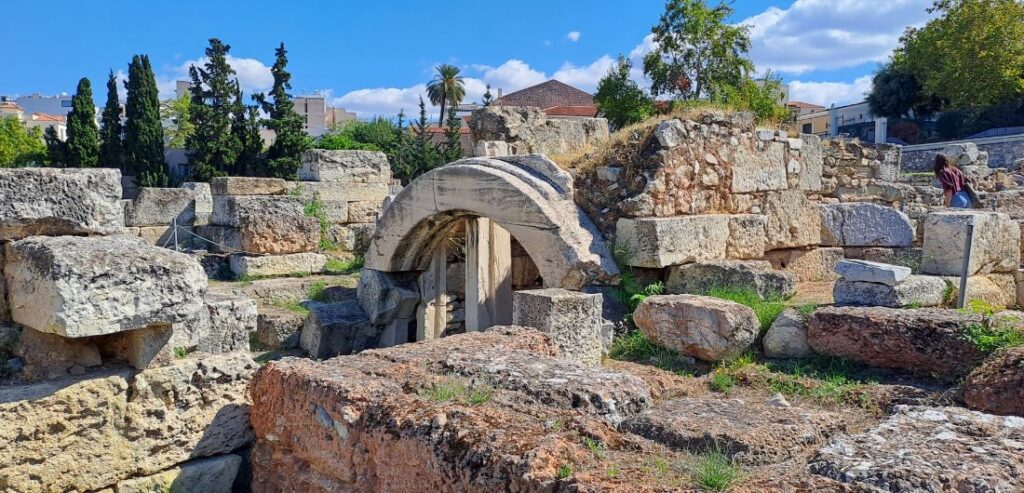
There were also gates in the wall, with two of the most important ones: the Dipylos Gate, which was the starting point for the procession of the Panathenaea to Plato’s Academy. And the Sacred Way (or Eleusinean Way), through which the procession of the Eleusinian Mysteries passed, heading, towards the sanctuary of Demeter in Eleusis.
Kerameikos Museum
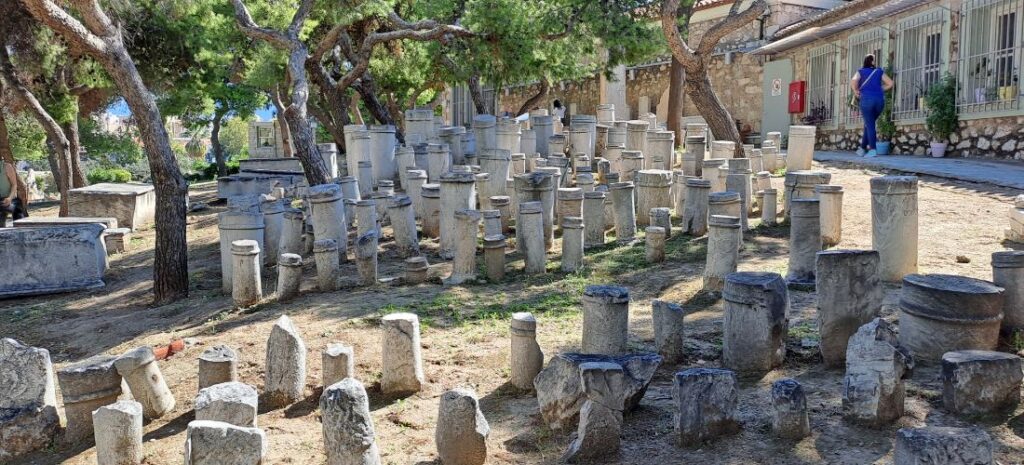
This is a relatively small and compact museum, with four rooms centered around an open-air quadrangle hosting all the findings from the German archaeological School excavations. Although small, the museum is characterized as the most exclusive and richest, mainly in burial exhibits, in the Greek territory.
It was built in 1938 with a donation from the German industrialist Gustav Oberlander. The Boehringer brothers contributed financially to the expansion of the museum.
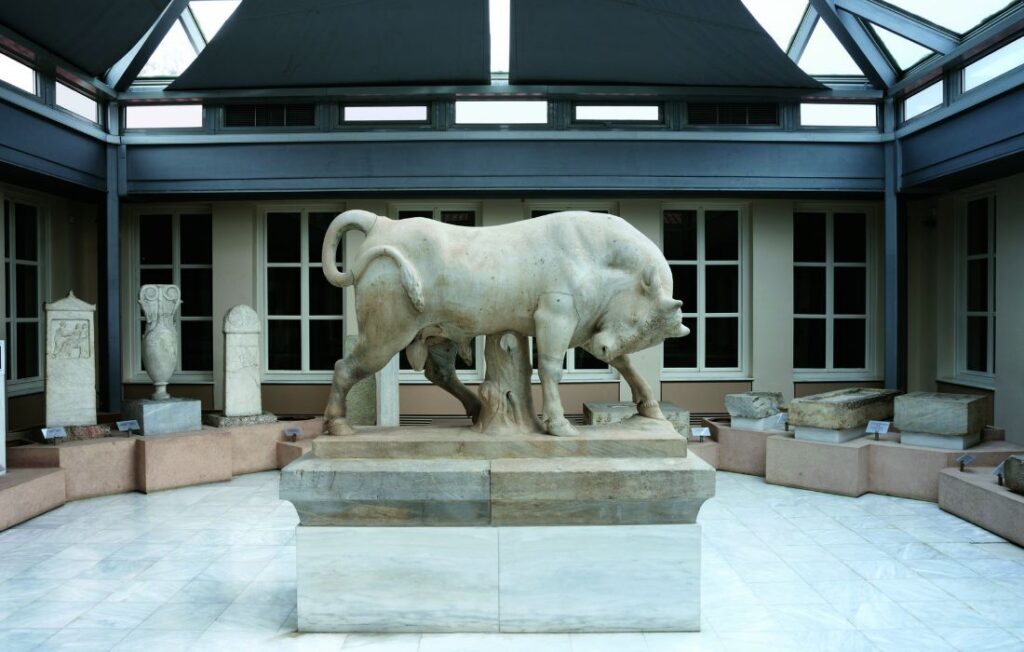
From the exhibits, you will learn about burial customs and traditions in various periods of Greek antiquity as well as a wealth of grave goods that accompanied the deceased to the next world. There are also many shells with the names of famous Athenians who were exiled, a usual tactic used to eliminate opponents of Athenian politicians.
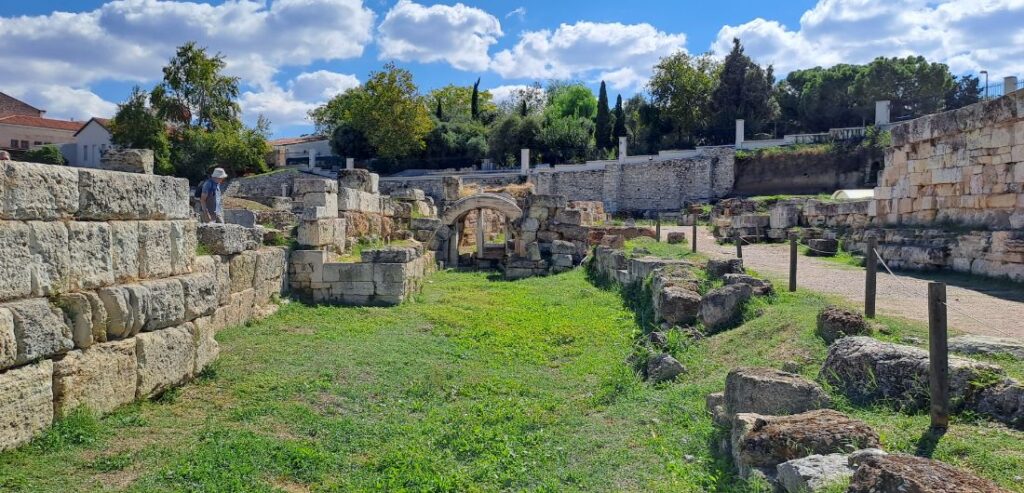
Note: The Museum exhibits the findings from the archaeological site of Exo (Outer) Kerameikos. The findings of the Inner Kerameikos site are exhibited in the Ancient Agora museum inside the Attalos Stoa.
Kerameikos Opening Hours & Tickets
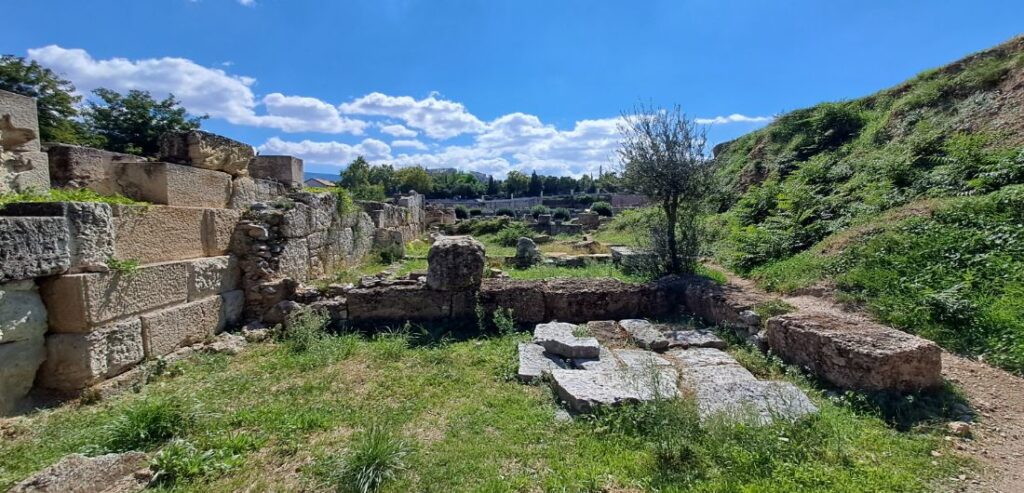
If you are visiting Athens for the first time, and plan to stay for at least 2 days then you should buy the ‘package’ ticket that gives you access to 7 major sites for the current price of €30 (valid for 5 days). The sites that you can visit with the package ticket are:
- Acropolis Hill and Slopes
- Ancient Agora of Athens and its Museum
- Roman Agora
- Archaeological Museum of Kerameikos
- Hadrian’s Library
- The Lyceum of Aristotle
- Olympeio (Temple of Olympian Zeus)
The entrance ticket to the Kerameikos is €8 per person between April and October and €4 between November and March. The Half-Price Entrance is not valid for the combo ticket. All sites take both credit cards and cash and offer an official ticket.
Free Entrance: From November to March, admission is free on the first Sunday of the month and on March 6th, April 18th, May 18th, the last weekend of September, and October 28th.
Kerameikos’ Opening Hours are 8:00 am to 15.00 or 17.00 or 20:00 depending on the month you are visiting (and the time of the sunset)
Tips for Visiting Kerameikos
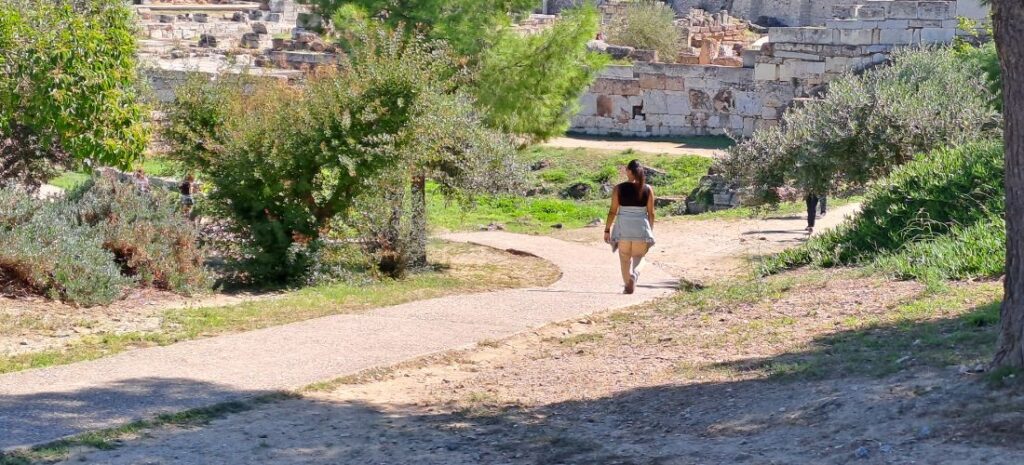
How much time do I need for Kerameikos?
Generally speaking, you should plan to spend at least an hour or 90 minutes at the archeological site.
Is Kerameikos Accessible?
Yes, it is. There is flat access with a ramp.
Is there a WC inside Kerameikos?
Yes, there is, free of charge with a ramp as well
Is there a shop inside the Museum?
Yes, there is a small shop.
Can I drink or eat inside Kerameikos?
You are not allowed to eat or drink inside any archaeological site in Greece, only water is allowed to carry around. There is no café/restaurant inside the site.
Recommended Guided Tours for Athens
- I highly recommend the Guided Tour of the Acropolis of Athens, Ancient Agora, and Agora Museum (4 hours) with a local licensed guide (from the Greek Ministry of Culture). It will bring into life how Athens of the 5th century BCE was.
- If you would like to enjoy a full-day, private guide to all Athens Highlights, (8 hours) then this tour is highly recommended with a Badge of Excellence from Viator.
Nearby Sites to Kerameikos
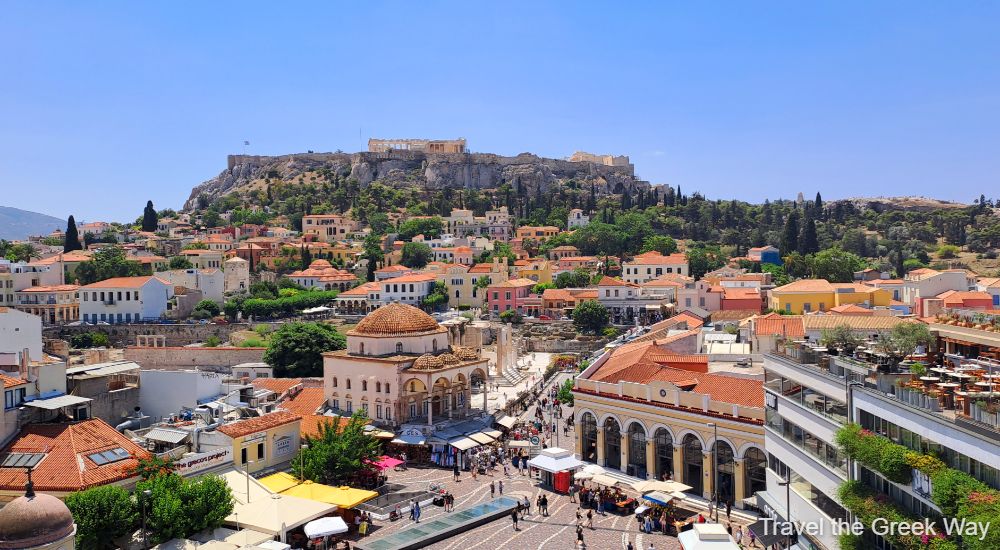
If you are visiting Athens for a short period then you have to make the best of your time. Near Kerameikos are some sites that will help you understand better the fascinating and diverse history of Athens:
- At the north end of the Kerameikos fence, find the Jewish Holocaust Site and the two Athenian Synagogues.
- Go to the 11th-century Byzantine church of Agioi Asomatoi across from the Thision metro.
- The Ancient Agora of Athens in Monastiraki, Adrianou St. On the parallel street, you will find Ifaistou St, which is flanked by many shops, selling all kinds of clothes, shoes, and antiques.
- Go to the Psyri area, which is hardly 10 minutes away, and choose one of its taverns for less tourist food.
- Visit Hadrian’s Library which is across from Monastiraki Metro station.
- Go to the Roman Agora and Kanellopoulos Museum in Plaka.
Athens Quick Reference
Plan My Trip to Greece
Do you need a custom travel itinerary or a transfer within Greece? Are you traveling solo, with your family or friends and need a tailor-made multi-day tour or a transfer?
If yes, please visit my dedicated Plan My Trip Page for a free itinerary!
How to Get to Athens Port (Piraeus) from Athens Airport
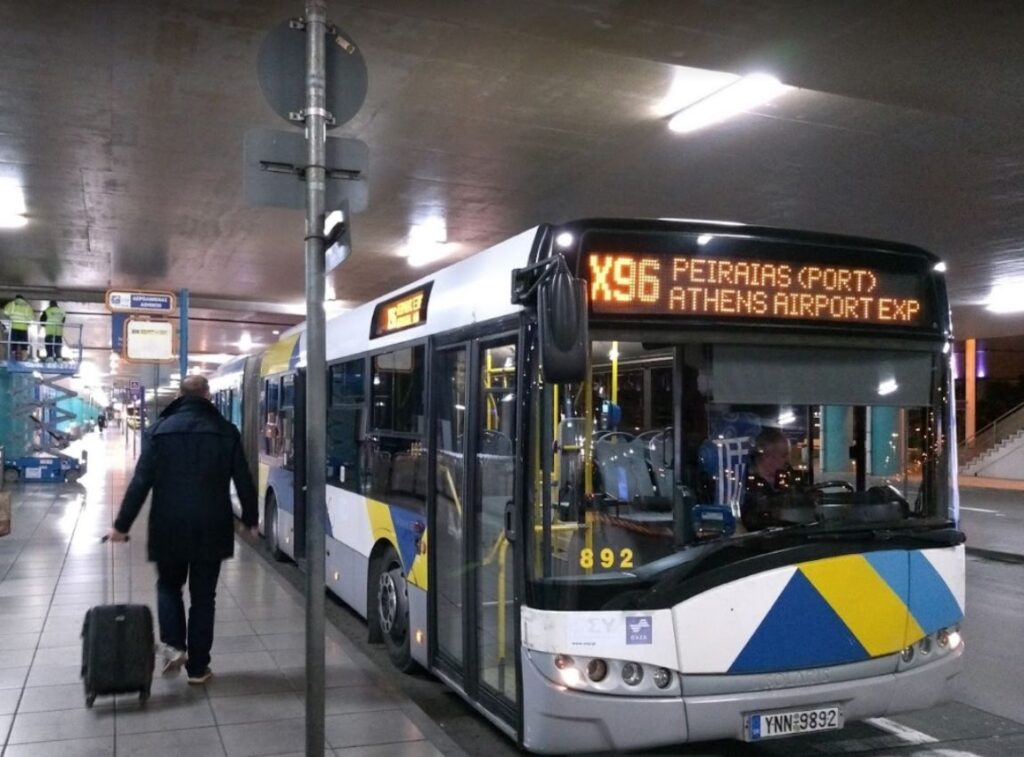
- Bus: If you are arriving at Athens International Airport you can travel straight to the port by taking the X96 express bus (€5.5, children <6 yo, free entrance), which departs every 40 minutes and the average trip lasts 1 hour – runs 24/7.
- Metro: (€9) is easily found across airport arrivals (blue line – M3) going directly to Piraeus port. The average trip to Piraeus lasts 1 hour.
- Taxis are available in front of the airport (around €40 to Athens, €55-60 to Piraeus (depending on the traffic in Kifisos), and take up to 3 or 4 people with small luggage)
- Rent a car with Discover Cars for reliable, new cars at affordable prices
- You don’t like driving but love hassle-free solutions? Book a Private transfer with an English-speaking driver from Athens International Airport to Piraeus Ferries, or anywhere else in Greece
- Are you looking for domestic flights in Greece? Check out the official Aegean Airlines Website.
My Most Popular Posts
- Greece Packing List – What to pack for a 10-day trip to Greece
- Where to Stay in Plaka, Athens’ Old Town
- Acropolis View Hotels & Apartments in Athens
- Best Athens Beach Hotels (By the Athens Riviera Coastline)
- Athens Budget Hotels
Did you visit the Ancient Kerameikos? Let me know what you think about visiting Kerameikos in the comments, I’d love to hear whether I managed to get it onto your bucket list! Till next time, Evgenia❤️
Essential Travel Info for Greece
- ‘Hello’ and ‘Thank You’ in Greek: “Ya sou” and “Efharisto”
- Booking.com: I use Booking.com mostly for Europe. It has over 1 Million properties to choose from, including everything from hotels to apartments and even hostels. And free cancellation!
- Expedia: I use Expedia for the best hotel descriptions and amenities and a rewards points system for the rest of the world.
- All-Inclusive Resorts in Greece
- FerryScanner to book ferries to the Greek Islands
- Rent an Affordable Car in Greece
- Athens Metro Website (timetables and ticket info)
- Map of Athens Metro
- Trains (Hellenic Train)
- Public Buses KTEL
- Get Your Guide: For all your day or multi-day tours and city guide needs, I use Get Your Guide
- Emergency Numbers Anywhere in Greece: AMBULANCE 166 – FIRE 199 – POLICE 100– EMERGENCY NUMBER 112
All rights reserved © Travel the Greek Way. Republishing this article and/or its contents (photographs, text, links) is strictly prohibited.
